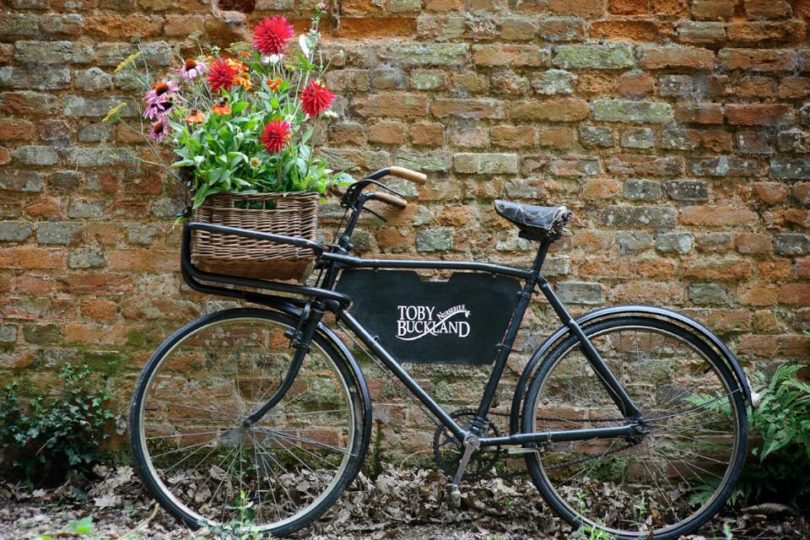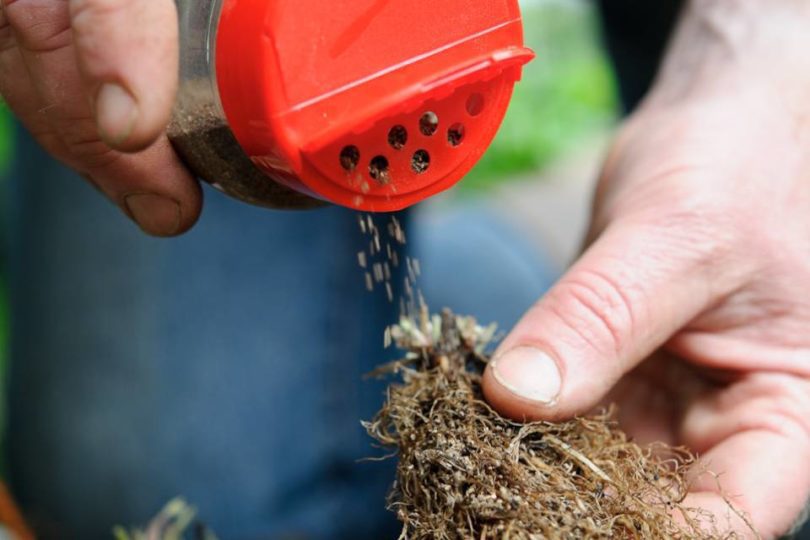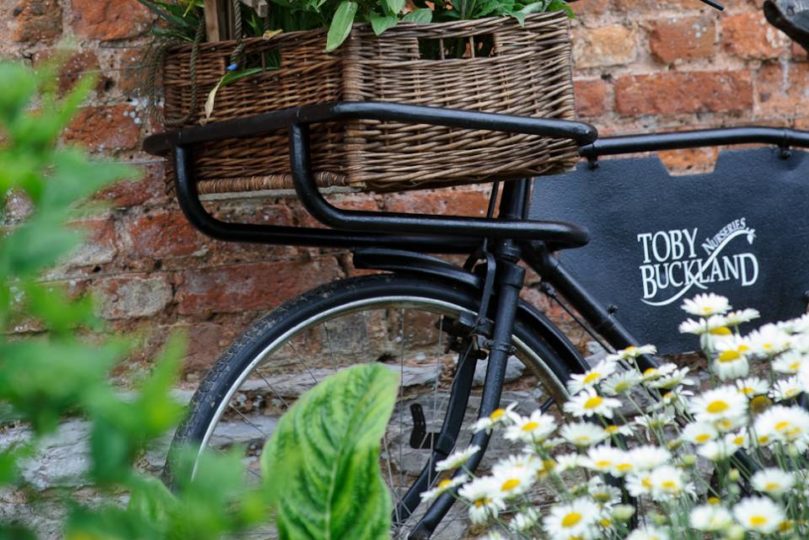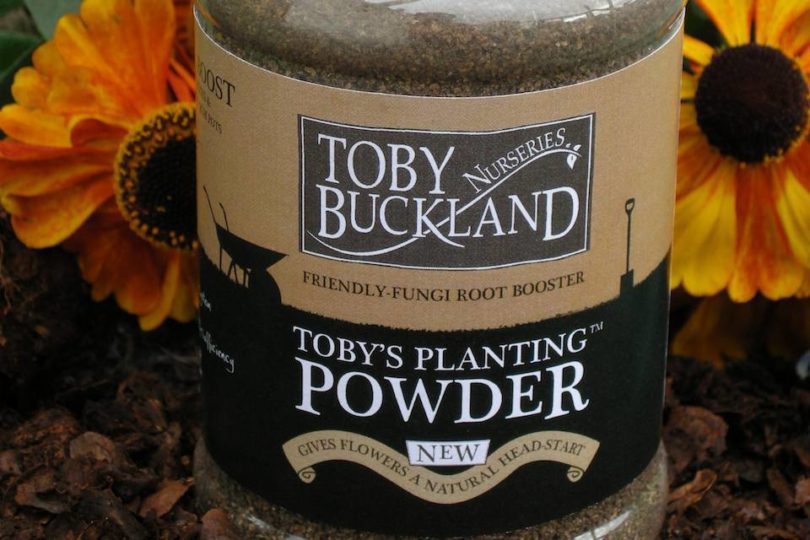On hearing him say ‘When it comes to strawberries, I like the bit just below the skin’, one could be forgiven for thinking Toby Buckland, a blue-sky sort of man. However, just forty minutes of conversation revealed an erudite, practical gardener, whose knowledge is far more profound than ever divulged on television.
From widespread press coverage, it’s clear that the Buckland PR drive has been rather successful, as most will already know of his new online venture; Toby Buckland Nurseries. Buckland offers a range of plants and products available for purchase, including his very own magic planting powder concoction of Mycorrhizal fungi, Biostimulants and nutrients. Though, what caught my eye was his selling of perennials as bare root plants. Gardeners are accustomed to purchasing bare-root roses, trees, fruit bushes/trees, but not necessarily, perennials. Odd, as it’s perfectly logical, but we have become so accustomed to the containerisation of plants, that this seems a rather novel idea. According to Buckland, containerisation only became widespread in the 1970’s, so despite appearances, is not necessarily the norm. A rather bemused Buckland explained that the sale of bare-root perennials is standard for the professional industry. ‘In my job when I’ve built gardens or done large gardening borders for people, I wouldn’t think twice about buying bare root. It’s just that amateurs don’t’, said the jovial Buckland. ‘It’s not the only way to do things, but just happens to be the most convenient for garden centres and has therefore become common practice. Anything outside of that, is considered a little bit odd’, he continued.
With the staggering estimate of 500 million plastic plant pots in circulation every year1, reducing our usage is certainly something to seriously consider. Though as online (plant) sales are on the rise, and pots continue to become better and more colourfully labelled, it is becoming habit that’s hard to kick. ‘Just think, even when you buy a perennial in autumn/winter that’s gone completely to ground, with just a little tuft of leaves, there will still be a big label with a bright picture of what the flower looks like’ notes Buckland. He is absolutely correct in saying that we never actually use those labels in the garden. ‘Far too gravestone like’ adds a bemused Buckland. Hence, ‘No pots, no labels, just rough and ready. Similar to shopping at a builder’s merchant instead of Homebase’. Bare-root purchases are not only lighter on postage, but also prevent the moving and hence loss of soil from one place to another, which is another significant environmental issue.
Just pragmatic
All good environmental policy, though Buckland refreshingly acknowledges that he is not evangelical when it comes to the environment. Despite being qualified in Landscape and Amenity Horticulture, hence qualified to use agricultural chemicals, he doesn’t use them and crucially hasn’t felt the need to use them. ‘However, if I needed to use them, I would’ admits Buckland. He went on, ‘I have always shied away from saying that I’m an organic gardener, even when presenting Gardeners’ World. For example, take some F1 seeds, they’ve been crossbred in Africa, flown over to the UK, planted with much care in one’s garden or pots. It’s almost too ridiculous to just let them die if the need for some form of chemical is required, but not doing so because one is a presumed organic gardener that doesn’t use any chemicals. The carbon footprint of those seeds is already huge’. Buckland certainly encourages the use of biological controls, but without the soapbox routine. No need for hypocrisy he adds. ‘I’ve never really wanted to bend anyone’s ear about it, because then I’d feel bad. Just think, I’ve been doing a lot of work in Scotland, and I don’t walk to Scotland. When I look at my garden footprint it’s massive and just think, I have three children’. For spring/summer plant purchases, practicality therefore takes over as Buckland’s plants are potted on and sold on in pots.





Horticultural vernacular
In June 2011, Noel Kingsbury published an interesting article in the Plantsman entitled ‘The long-term performance of herbaceous perennials‘. The article discussed that despite the prototypical portrayal and the best possible care, some perennials are just not programmed to be everlasting. Hence, that some perennials, will simply cease to be, before their defined 2+ age status. Kingsbury’s fundamental point is that plants’ ability to thrive in the long-term is prescripted in their genetic make-up. Fascinated by the article, I wrote a subsequent blog on the subject entitled ‘To be, or not to be a herbaceous perennial’. Kingsbury’s research raises the question as to whether perennials should be reclassified, and hence provide the public with information as to the (natural) limitations of some perennials. This information is invaluable to gardeners, as one could better determine which plants have stronger ‘staying-power over time’ and their associated trade off(s); vigorous spreader, slow to establish, nutter self-seeder etc. Failure of reference literature and especially plant labeling, to inform the public can therefore often lead to disappointment, even for the most competent of gardeners.
As of much interest, the opportunity to quiz a new nurseryman on this noteworthy subject was quickly seized. Despite much respect for Kingsbury’s work and research, and encouraging of new thought on the subject, Buckland is not entirely convinced. According to the new nurseryman, garden soil type much determines the long-term performance of herbaceous perennials. Kingsbury’s argument is that long-term performance of herbaceous perennials is driven by genetic traits, environmental effects such as garden micro-climate and soil type therefore, having limited impact. ‘Noel is correct in saying that there is no one-size fits all, as seems so presumed in horticultural terminology and language. Though having gardened on very sandy soils and on thick clay soils, it’s completely the opposite. I have never looked at a bit of ground or ever moved to a garden and done the same things, in the same way’, says Buckland. ‘I remember for Gardeners’ World, I had to cope with Monty’s garden at Berryfields, which was a bit of a disaster as it was on very heavy clay soil. Though, when the gardening team went up to Greenacres, which is on very sandy soil, we couldn’t garden in the same way at all’, he added. According to Buckland, it all comes down to the fact that some plants perform better on some soils, than on others. ‘Echinops Bannaticus for example, will self-seed prolifically in loamy soil. Whereas on heavy soil, the same plant is capable of just sitting there in a single clump and not do very well at all’, explained Buckland. He further pointed out that, clay soils are more prone to slugs, which can damage crowns and hence inhibit the long-term performance of an herbaceous perennial.
Despite being somewhat dismayed by Buckland’s opinion, his point is valid. Sadly, it does bring back the question of my gardening aptitude, as Kingsbury’s research presented answers, as to why much loved and cared plants such as Monarda and Echinacea, are very unreliable in our herbaceous borders. According to Buckland, it is down to their unsuitability for our soil type. Curiously though, in spite of our unforgiving soil, it has happened that they survived the winters and put on a superb show. They just don’t do so, consequentially. This could be explained by Kingsbury’s genetic argument, as in this case soil type is a constant. Though Buckland may have a point too, in that some years, perhaps due to increased moisture content, our soil may be especially inhospitable, and perhaps very hospitable for slugs hungry for Monarda’s? Either way, it was clear that Buckland didn’t think much of my pertinacious plant choices, for our soil type. Stubbornness will undoubtedly prevail.
Perennial power napping
Am sure that this is nothing but pathetic personal anxiety, but I always worry about when it’s just too late to move and/or divide perennials in autumn before the onslaught of winter frost. After moving or dividing, how long do they need to recover and settle, prior to frost? Or am I just barmy, and they don’t need to recover prior to winter, but recover during winter, meaning that one can move plants all through autumn and winter? Our current weather conditions have confused this query further. Buckland explained, that though dormant, in winter plants certainly continue to grow. When a plant is dormant all its life processes are going on but at a very slow rate. ‘Imagine perennials as trees, which in winter draw on its nutrients and sugars, back into itself through its vascular system. This purpose, using up much energy, works similarly to salting the roads, making the tree, and hence plant, less vulnerable to frost’. Sugary liquids have a lower freezing point than pure water making plants more resistant to ice formation, helping them survive winter. That means, that despite being dormant, there is still much activity under ground. Soil too acts as a thermal insulation, as its surface may freeze solid, but a couple of feet down, the temperature may not vary much over the year, compared to the substantial fluctuations at the surface. As a result of the constant soil temperature, some plant don’t go completely dormant, but simply carry on growing and rooting.
Granted, superbly wishful thinking on my part, but when it comes to an actual time frame for the last possible month/day/time when one can move a plant, the answer is as per always ‘That depends on what it is’. According to Buckland ‘When plants are growing, it’s fine to move them as their tissues get damaged inevitably, even when just knocking out of a pot. The damaged tissue will recover, unless the plant is not growing and hence just sits there in the wet soil with the danger of rot getting into the tissue. But when the plant is growing, there’s a pressure system within the plant (Turgor), that ensures the wound heals and grows beyond it’. He continued, ‘It’s all to do with the re-planting. If you planted on a frosty day, and you buried frost into the soil, and even if it was milder after then, you could go back to your plant a month later and probably still find that frost in the soil as it’s so well-insulated. Similarly, when it’s warm you don’t want to be moving plants, or equally when it’s raining heavily, you don’t want to muck around with the ground. Let it let drain away first, then plant’. He went on to explain that as our garden soil consists of heavy wet clay, it takes time to for the temperature of the soil to increase as it holds much water and hence has a high thermal mass. That is the reason why our garden is always so far behind from other gardens, even within a minor 10-20 mile radius. Moreover, due to the wet clay our plants start slower, hence longer period when they are not growing, and just sitting in wet soil.
As for my annual division/moving perennial anxiety? Taking into consideration our location and soil type, division/moving plants may best be left to early spring, as opposed to autumn. Though that is not without complications as at that time, the herbaceous borders are crammed with alliums. Chomping, at clumps of perennials, whilst dodging young Alliums, will undoubtedly lead to tears. The other thought, is to split in autumn and pot up, for planting in spring. Hmmm, this will need some further thought….
Magic mushrooms are the new black
An increasing number of products containing Mycorrhizae are now available on the market, such as Rootgrow, licensed by the RHS, Roots Boost by Peter Beales and last year, Buckland launched his very own cocktail called; Toby’s Planting Powder. Buckland explained that he’s used some form of Mycorrhizae since very early on in his career and therefore developed a mix that suited his needs. Now, bottled and available for the masses. Having never used any form of Mycorrhizae before, curiosity overcame and a sample of the magic mushroom powder was sent. A very unscientific experiment is in process where some lucky recipients in the greenhouse, young cutting plants and re-potted biannual seedlings have enjoyed the ‘peppering’ treatment, whilst the control group have gone in their pots, cold turkey. So far so good, on both sides, but it is early days.
‘Trees and plants have roots that have evolved in symbiosis with soil-dwelling fungi’, explains Buckland. The fungi live off the sugars that plants produce through their chlorophyll production, and the plant uses the fungi to gather nutrients and moisture from the soil. By attaching themselves to the plant’s root system, the quick spreading fungi, become part of the plant, improving the host’s nutrient absorption ability. This delicate balance is often disturbed in a normal garden due to digging, addition of artificial fertilizers, hoeing, uncovered ground, or simply not having enough humus, or organic matter in the ground. But according to Buckland, ‘The addition of Mycorrhizae on planting boosts the levels of these natural fungi, helps the plant develop a better root system and ensures the plant is in a better position to overcome drought and other potential problems’ argues Buckland. He is not alone, Colin Crosbie, Curator RHS Garden Wisley, also confirms the beneficial nature of Mycorrhizal fungi, now much used at RHS Garden Wisley for planting trees, shrubs and perennials. According to Crosbie ‘For me, using (rootgrow) mycorrhizal fungi has become one of the most important ingredients to ensure planting success’2.
Buckland explained that similar to our digestive systems (at least if you believe the adverts), there both friendly bacteria, as well as malignant pathogens in soil. One of the more environmentally friendly ways to stop/limit the unfriendly sort, is by loading the soil with ‘friendly’ fungi. Whilst Buckland was working for the University of Cambridge Botanic Garden, they experienced a problematic infestation of Armillaria (Honey Fungus), a malignant pathogen. To treat the problem, they encouraged other fungi by adding more wood, bark etc. to create a richer environment and hence encourage a more naturally balanced system. ‘Problems arise in gardens as we’re all a little bit too tidy. We clear our gardens, hoe the soil, use artificial fertilizers, which actually makes plants more vulnerable’, asserted Buckland.
Any official recommendation to be less tidy, is very welcome indeed. Expecting trouble, I was surprisingly delighted to hear that my stubborn refusal to wash our plastic pots, seed trays, root trainers etc., prior to seeding, was not a crime, despite frequent use. In fact, delightfully Buckland, claimed this exercise to be completely unnecessary. ‘That was just the type of punishing job an 18th century gardener would give to the stove boy every year’, laughed Buckland. Though he did encourage vigilance for possible insect eggs up under the rims, but that’s hardly as tedious as washing them. Hence, a futile job that from now on, can be completely ignored even when annually listed in the ‘jobs of the month’ features in gardening glossies.
Labelling technology
Buckland is not shy of new technology and has adopted QR codes. A Quick Response code is basically a two dimensional bar code. Reading QR codes requires a simple smart phone application, which links to a designated webpage for further information. The implication for plant labelling is interesting, but perhaps more so for (biological) chemicals used in the garden. Buckland’s magic mushroom powder is therefore adorned with this bit of technological art. As Buckland admitted, most people never actually read the label, or read it properly. ‘So much about gardening, is just about understanding the reason why you do something’, he explains, so providing additional information, be it conventionally in words on the label, or on Smartphone via a QR code, all just helps increase our horticultural knowledge. A QR code linking to a short video of correct usage and warnings may be a good alternative. According to Buckland, he always has his phone with him when working in the nursery, though I can’t ever recall gardening with my phone in my pocket. Just too cumbersome and would undoubtedly be lost or damaged whilst digging. The trade is increasingly using QR codes, now also seen on garden trails at RHS gardens. Full adoption by the public remains to be seen, though as Smartphones are set to take over the world, the future for QR codes seems assured.
Mystery strawberry
Perennials much the focus, but Buckland Nurseries are expanding into other areas such as fruit plants and bushes, including a new strawberry variety. Drawn to new growing techniques, Buckland is working on bringing a new variety to market that fruits constantly from May until November, in its first year. For the finicky man who likes the taste of what’s just underneath the strawberry’s skin, the flavour is allegedly outstanding. Crucially, potential success of the new variety is already being measured, as it should, in terms of the amount of shortbread required for it to be paired with. Oodles I think, plus generous dollops of clotted cream.
Buckland is much grounded man, steeped in pragmatic gardening practice. The new nursery venture looks set for success, but I wish him much luck in any case.
